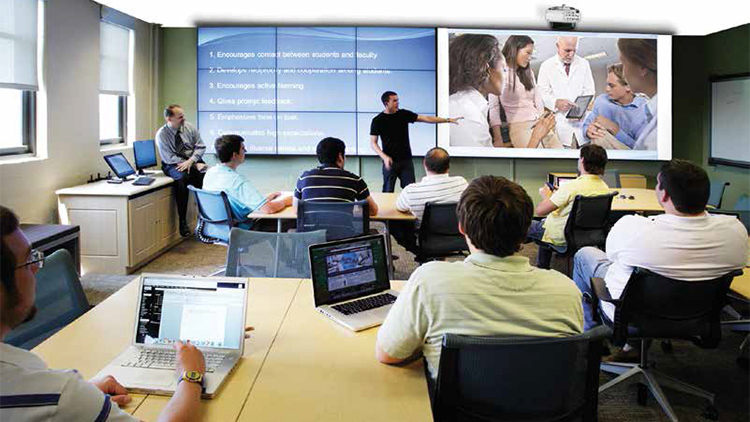Question: How do you catch the attention of a GenZ student who can’t be bothered to lift her head from her iPhone?
Answer: Design campus digital signage systems that bring all the efficiency and engagement they expect from media, and make the system as robust and user-friendly as the multitude of devices carried by all campus stakeholders, be they pupils, professors, administrators or alumni. This is not just about making a fun show for the kids, it’s about building value into a platform that can adapt with the ever-shifting demands and expectations of discerning audience. Here’s how to connect an atmosphere of learning with smarter setup.
1. BE BRAVE AND LET THE STUDENTS RUN THE SHOW.
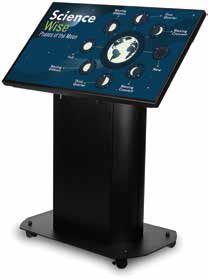
Toshiba’s Virtuoso When implementing campus-wide digital signage, it is important for schools to consider technologies that not only inform but also engage their students. One way to accomplish this is by creating a separate account for students to publish content—with staff approval—including video highlights from athletic events, restaurant reviews and even ads for study groups. Use an interactive solution like Toshiba’s Virtuoso, which was designed for high-use environments and allows users to explore, expand, mark up content, watch videos, play games and access information.
—Joe Contreras, VP of Product and Solutions Marketing, Toshiba America Business Solutions
2. DITCH THE PC?
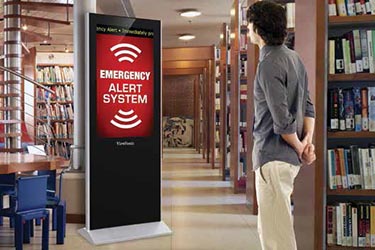
A ViewSonic ePoster solution for emergency alerts. School campuses no longer need high-powered PCs and expensive IT network management systems to implement a campus-wide digital signage network. With the ease of use and lower costs of implementing digital signage, the cost per screen is more affordable and systems are easier to install than they’ve ever been. For example, ViewSonic’s CDE5502 is a cost-efficient, 55-inch full HD display that comes with an integrated USB multimedia player, as well as built-in vController software. Multiple connectivity options allow users to hook up the display to other devices as well. Today’s ARM-based processors and Android-based media players are now bundled into displays, effectively providing better ROI, as well as eliminating complexities of networking and managing a system.
—Gene Ornstead, Director of Product Marketing, Digital Signage/Large Format Displays, ViewSonic AmericaPanasonic’s EF1 Series.Another exciting example of PC-free digital signage comes from Panasonic. The company is offering a built-in USB media player which simplifies set-up and maintenance which allows playback of video or still images via USB without a set-top or PC. This feature also enables quick and easy updates to content via a LAN connection even after installation. Connecting displays via a LAN connection allows delay-free synchronized playback on multiple displays making content management easier than ever. Check out the Panasonic EF1 Series Professional Displaysfor 84- and 75-inch models.

3.OR TURN THAT PC INTO A HIGH-END VIDEO WALL CONTROLLER.
Students on campus today have been raised surrounded by screens—the little ones in their pockets but also digital signs and public displays. Colleges and universities today need to step beyond traditional digital signs to grab attention on campus, and that’s what’s driving a boom in on campus video wall deployments. Userful helps educational institutions with a more cost-effective and simpler video wall, turning a standard PC into a high-end video wall controller that delivers content over the network. Up to 60 screens and 8K source content all run by a single PC with virtually unlimited internal and external content sources with options like preset zones and angling of displays for a one-of-a-kind artistic style video wall.—Daniel Griffin, vice president, Userful Corporation
4. LIKE MOTHS TO A FLAME, SO STUDENTS ARE DRAWN TO LED DISPLAYS.
How do you impress a prospective Gen-Z student? Trigger an LED display through a chip in the student’s nametag to light up with a personalized greeting as soon as the student and parents walk into the student center for an admissions tour. For athletes, sports boosters and alumnae, trick out your teams’ locker rooms and practice facilities with LED displays that can be used to review game footage, be turned into giant television screens for watching opposing teams, or used as a monitor for playing video games.
—Deborah Fisher, vice president of Global Marketing, NanoLumens
5. WHAT’S YOUR SCREEN’S MOTIVATION?
Selecting the right digital signage for your campus can be difficult, but the most important thing to ask yourself is what are you trying to accomplish by using it? Whether it’s for wayfinding, classroom/lecture hall presentations, it’s important to know the primary use in order to select the right display for your needs. Then avoid distraction from the content’s purpose with ultra-narrow displays like NEC’s new UN551S AND UN551VS, with narrow bezels of just 0.9mm.
—Michael Ferrer, director of Solutions for Sales, NEC
6. KNOW ALL THAT YOUR HARDWARE CAN DO AND SAVE FEES ON SOFTWARE.
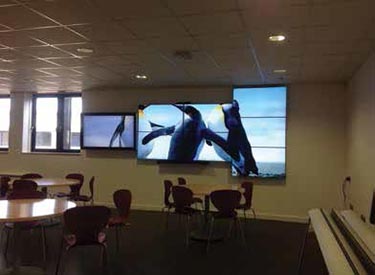
HASLA (Hastings and St Leonards Academies) systems include DATAPATH Ltd & InFocus. Leverage the hardware, and let it do the heavy lifting. Too often users buy highly capable hardware, but do not take advantage of its ability to process high-resolution or streaming video, thus stifling creative display arrangements and layouts. In one successfully creative configuration, a school in Sussex County, England controls four Samsung SM460 display screens with a single Datapath x4 multi-screen controller, while two adjacent standalone Samsung screens are used for videoconferencing and live Twitter feed functions.
—Nathan Nye, VP of North American Sales, Datapath
7.ADD EVEN MORE SAFETY TO THAT 24/7 OPERATION.
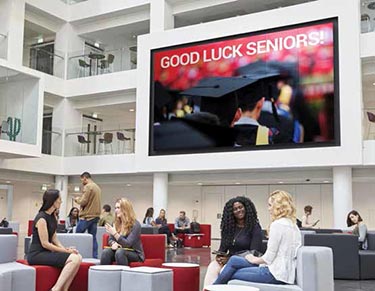
Black Box powers this university environment (right). An information or wayfinding screen can be configured to change to emergency notification during crises—based on a signal sent when a secure door is opened or when an environmental condition occurs. The alert can be sent to all of the screens via the network for instant notification. With Black Box’s iCOMPEL, a GPIO interface even allows users to connect their signage system to alarms and other external sensors.
—Erik Indresovde, director of AV Products, Black Box Network Services
8. GO FOR NOT-BROKE.
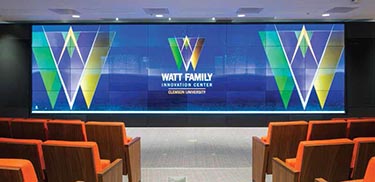
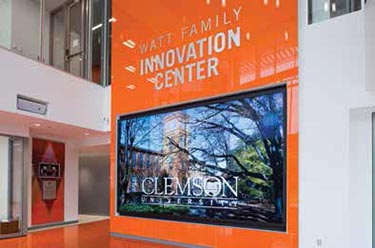
Clemson University’s Watt Family Innovation Center features Planar solutions. For public venue installations such as digital displays on university campuses, it’s important to remember that consumer-grade products aren’t intended for the demanding requirements of a 24-hoursa-day, seven-days-a-week environment. Universities should consider display manufacturers that can offer options such as the Planar Extended Ruggedness and Optics protective glass to further safeguard displays against breakage both in transit and while in use in public spaces.
—Jennifer Davis, CMO, Leyard
9. MAXIMIZE THE NETWORK.
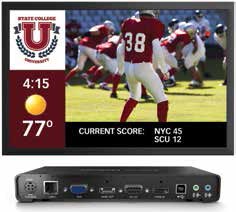
Matrox’s Maevex Encoder within a campus network. Assuming you’re looking to distribute the same messaging, video or advertising in many places across campus, there’s no easier way than relying on the network. H.264 allows a standard network to become the distribution backbone for digital signage, offering low-complexity, low-cost, low-bandwidth solutions for high-quality signage distribution. Matrox Maevex H.264 encoders capture, encode and stream full HD 1080p60 content over a standard IP network to power attention-grabbing digital signage platforms.
—Ron Berty, Business Development manager, Matrox Graphics
10.GOING WITH PROJECTION? GO ROBUST WITH LASER.
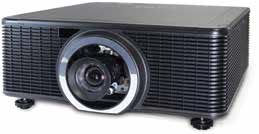
Eiki’s EK-810U 8,000-lumen laser projector For large-venue campus signage utilizing image projection, laser technology is preferable as it is less fragile than lamp-based systems and offers nearly instant on/off performance. Eiki’s EK-810U 8,000-lumen laser projector, with its 24/7 operation, 20,000-hour laser light source, and IP6 rating for a dust-proof optical engine resulting in maintenance free operation, is a good example of a system optimized for this type of application.
—Steve Rubery, Business Development manager, EIKI International
